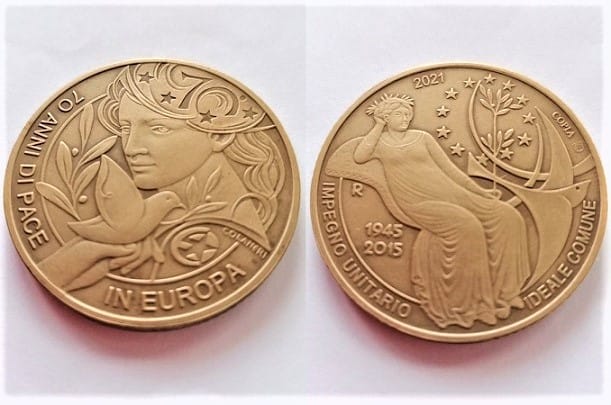- In 2017 in Berlin, the “70 Years of Peace in Europe” coin minted by the Italian State Mint was awarded as the most beautiful coin in the world.
- It was a recognition of Italian creativity and mastery for the beautiful artistic engraving and for the perfection of printing and finishing.
- Progetto Editoriale is, therefore, proud to present an exclusive reproduction.
The reproduction is from the original by the internal department of artistic engraving of the Istituto Poligrafico e Mint dello Stato produced in a numbered and certified edition, to give full evidence and dissemination to a great historical event that has never occurred before within the Old Continent.
Beauty, amazement, history, peace, art, culture – these are the elements that intertwine in the presentation conference at the Mint Museum in Rome of two medals of extraordinary importance born from the collaboration between the Progetto Editoriale Publishing House and the State Mint.
The speakers for the event were the Editorial Project Director, Francesco Malvasi; Eng. Matteo Taglienti, Head of the Mint and artistic productions supply chain at the Integrated Solutions Development Department of the Poligrafico; Ing. Antonio Cascelli, Director of the State Mint plant in via Gino Capponi; and Franco Salvatori, Honorary President of the Italian Geographic Society.

The location is a unique and exceptional place, open to the public on special occasions for important events. The Museum of the Mint of Rome, born in the early nineteenth century as a Numismatic Cabinet of the papal monetary establishment and handed over to the Kingdom of Italy in 1870, contains real treasures: coins, medals, cones, punches, wax models, and copies of each newly issued coin and medal.
Not only that, ancient machinery for metalworking and the production of coins and medals, nineteenth-century pantographs, and equipment used in the various departments of the Italian Mint built on the Esquiline hill (Rome district) in 1911 can be seen here.
The Beauty, The Peace
From the “Most beautiful coin in the world” to the medal dedicated to Peace in Europe, a path was created in 2015, when a 10 euro coin dedicated to the theme of peace was born from the creative flair of Maria Carmela Colaneri, artist of the School of the Medal of the IPZS (State Mint Polygraphic Institute) during the last war in Europe. In 2017, the coin was awarded as the most beautiful in the world, excelling among the proposals of 40 other national mints, and in 2019, the primacy was reconfirmed in St. Petersburg.
Currently, the 10 euro coin is nowhere to be found, and its market value is constantly increasing. In 2020, the dramatic year of the pandemic, Progetto Editoriale decided by mutual agreement with IPZS to underline the centrality of peace, security, and civil coexistence through a reinterpretation of the “70 years of peace in Europe” currency.
The engraving mastery of Silvia Petrassi has given birth to a new medal with the same representations and symbols, with the aim of stimulating moments of reflection and awareness in a highly critical international geopolitical framework with many questions for the future.
Ihe ịtụnanya
Which historical figure, if not that of Frederick II of Swabia, could best embody the values of peace? The emperor of the Holy Roman Empire, King of Sicily and much of southern Italy, was in fact a cultured and far-sighted forerunner, a shrewd and innovative politician, passionate about literature and art, so much so that he earned the nickname of Stupor Mundi.
The same name was given to the Medal in the form of a coin, created by Remo Carboni and minted by the Italian Mint, which has been presented together with the Peace Medal.
The artist drew his inspiration directly from the Augustal, the ancient gold coin issued in 1231 and dedicated to Frederick II. The obverse featured the profile of the Emperor in the manner of the Caesars, crowned with laurel, while the reverse featured the Roman eagle with the inscription FRIDERICVS.
In the current reinterpretation, the effigy shown on the obverse has been replaced with the famous historical seal of the sovereign, never reproduced in this way, while the back has been reproduced as admirably as the original.
History
The presentation of these two medals, therefore, represents a journey through the history of Italy and Europe, amplified by the precious context offered by the Mint Museum, a place that underlines the ancient tradition of the Italian State Mint, which has become today a technological and avant-garde model while always maintaining its artistic and artisan soul.
“In light of recent events in the Middle East, Northeast Asia, Africa, and in Afghanistan, our group has decided to create a medal dedicated to peace and to values that underlie this,” declared Francesco Malvasi, Director of Progetto Editoriale. “We linked it to the creation of an imaginary coin, the Stupor Mundi, a one small masterpiece of great intrinsic significance. This very important design commitment represents our real contribution to those that can be identified, we hope, as the guidelines for a strong, welcoming, united, and supportive Europe, a point of reference and comparison for all countries and peoples of the world.”
IHE Ị GA-Ewepụ na edemede a:
- From the “Most beautiful coin in the world” to the medal dedicated to Peace in Europe, a path was created in 2015, when a 10 euro coin dedicated to the theme of peace was born from the creative flair of Maria Carmela Colaneri, artist of the School of the Medal of the IPZS (State Mint Polygraphic Institute) during the last war in Europe.
- The reproduction is from the original by the internal department of artistic engraving of the Istituto Poligrafico e Mint dello Stato produced in a numbered and certified edition, to give full evidence and dissemination to a great historical event that has never occurred before within the Old Continent.
- The Museum of the Mint of Rome, born in the early nineteenth century as a Numismatic Cabinet of the papal monetary establishment and handed over to the Kingdom of Italy in 1870, contains real treasures.























